- 0 Shopping Cart £ 0.00 -->


Cyclone Idai
The cause, primary and secondary effects and immediate and long term responses to Cyclone Idai
Cyclones are tropical storms that occur in the Indian Ocean. Cyclone Idai is the strongest tropical cyclone on record to affect Africa and the Southern Hemisphere.
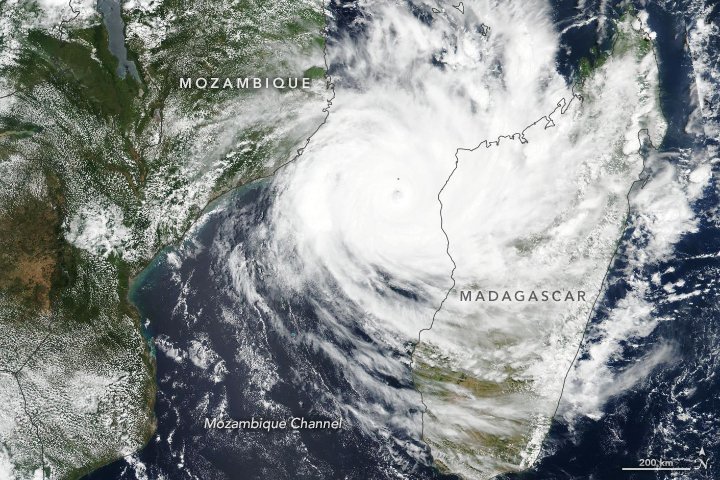
Cyclone Idai satellite image
What caused Cyclone Idai?
In early March 2019, a storm cell brought heavy rains to Malawi before heading out to sea off the coast of Mozambique. The storm intensified into Cyclone Idai and returned to land on the evening of 14th March 2019. Often, storms that develop there don’t strengthen as much as those that form north and east of Madagascar, but Cyclone Idai was fed by warm water temperatures. The storm, with winds of up to 115 mph/185 kph and more than 150mm of rain in 24 hours, wreaked havoc in the Mozambique port city of Beira, home to 500,000 people, along with surrounding districts. It then swept inland and on to Zimbabwe. The storm caused widespread devastation and the loss of life and livelihoods of hundreds of thousands more people.
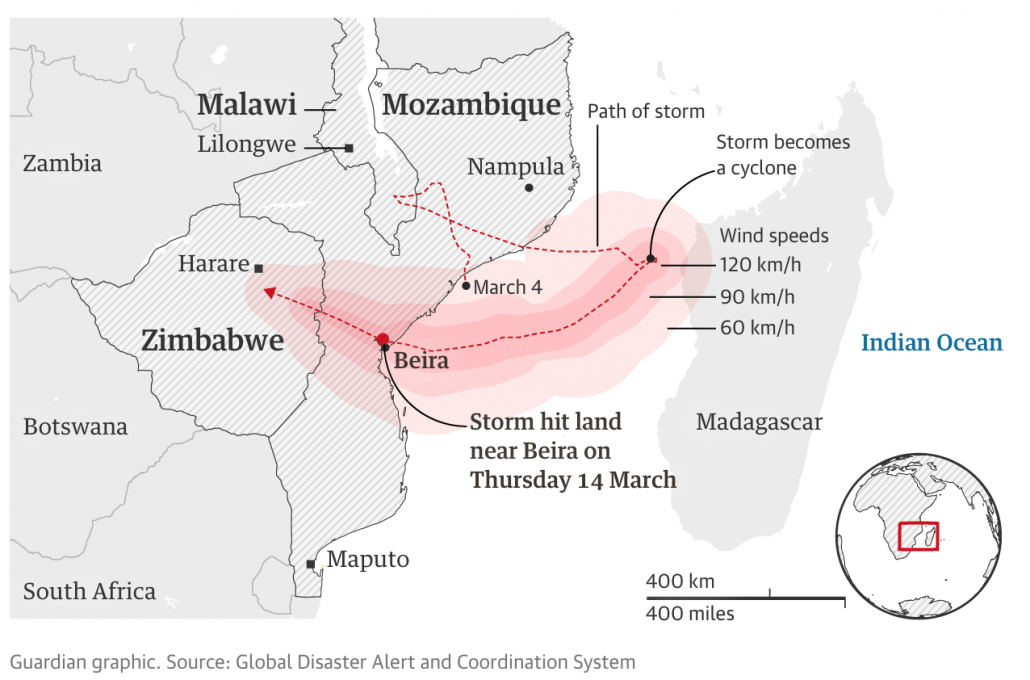
The location of Cyclone Idai
March 3 2019
Tropical disturbance forms.
The tropical disturbance that would become Cyclone Idai develops and begins to strengthen near the coast of Africa.
March 5th 2019
Heavy rains cause severe flooding across Mozambique and Malawi.
March 11 2019
Tropical depression.
Now a tropical depression, the storm becomes more intense between coastal Africa and Madagascar.
March 14-15 2019
Tropical cyclone idai makes landfall.
Tropical Cyclone Idai makes landfall near Beira, Mozambique, as a Category 2 storm with sustained winds exceeding 105 mph.
March 20 2019
Heavy rain continues.
Heavy rains continue along with search and rescue operations and damage assessments.
March 21 to 27
Aid response.
Governments and humanitarian aid agencies begin responding with life-saving relief supplies to the affected areas.
Search called off
The Mozambique government calls off the search for survivors of Cyclone Idai.
Cholera Cases
Cholera cases in Mozambique top 1,400, according to health officials.
What were the effects?
Flooding in Southern Africa has affected nearly 3 million people in Mozambique, Malawi, and Zimbabwe since the rain began in early March and Cyclone Idai struck March 14 and 15. The death toll has exceeded 843 people, and many more remain missing. Over 1 million people were displaced by the storm.
It was not just heavy rainfall that led to flooding, storm surges between 3.5m to 4m hit the coastal city of Beira. The ocean floor along the coast by Mozambique is conducive to give storm surges.
The image below shows the area around Beira before and after the cyclone.
According to the Red Cross, up to 90% of Beira, Mozambique’s fourth largest city, has been damaged or destroyed. The devastated city became an island amid the flooded area with communications, power and clean water severely disrupted or non-existent. Houses, roads and crops disappeared beneath the water that was six metres (19ft) deep in places. Rescuers struggling to reach survivors who may have spent up to a week sheltering on roofs and in trees. A woman gave birth in a mango tree while escaping floods in central Mozambique.
The coastal lowlands, located between the higher plateau and the mountainous areas to the west near the Zimbabwean border were the hardest hit by the floods.
At least 180 people in Zimbabwe known to have been killed by landslides triggered by Idai. Nasa satellite images depict the extensive landslide activity associated with Cyclone Idai . The landslides were partly caused by deforestation.
People were still being rescued a week and a half after the storm.
As flood waters receded, survivors struggled to obtain food, clean water, and shelter.
According to the World Bank the cyclone affected about 3 million people, damaging infrastructure and livelihoods. Unicef reported that over half of the 3 million people in urgent need of humanitarian help were children.
The UN World Food Programme (WFP) says that Cyclone Idai wiped out a whole year’s worth of crops across swathes of Mozambique, Malawi and Zimbabwe. At least 1 million acres of crops were destroyed.
The cyclone is expected to cost Malawi, Mozambique and Zimbabwe more than $2bn, the World Bank has said.
Cholera infected at least 1,052 people in Mozambique’s cyclone-hit region.
What was the immediate response?
As part of the forward planning for severe weather, safe zones had been created in rural areas of Mozambique for evacuation above the flood plain . However, the flooding was far worse than had been expected.
The meteorological office of Mozambique, Inam, issued weather alerts as the storm developed. The highest possible alert was raised by the government three days before the cyclone struck, telling people to evacuate threatened areas.
Some people were evacuated by boat before the cyclone struck, however many people in rural areas didn’t respond to the warnings or were not aware of them.
According to the mayor of the Mozambican city of Beira, the government failed to warn people in the areas worst hit by Cyclone Idai despite a “red alert” being issued two days before it struck.
The South African air force and the Indian army, which happened to have a ship in the area, drove the initial rescue effort. Opposition groups in Mozambique blamed the limited government preparation and response on corruption.
Last year, the government of Mozambique received support from international donors for a disaster fund of $18.3m (£13.9m) for 2018 and 2019. This is the main source of funding for any disaster response and is intended specifically for search and rescue within the first 72 hours.
More than 130,000 newly homeless people were taken into reception centres.
Two weeks after the disaster 900,000 doses of oral cholera vaccines arrived in the cyclone-battered Beira city, from the global stockpile for an emergency, according to the World Health Organisation (WHO).
As flood waters receded the International Committee of the Red Cross supported flood-affected communities to recover bodies, identify them and bury them in clearly marked graves.
The Mozambique government announced the search and rescue operation to find survivors from Cyclone Idai was over two weeks after the storm.
With the help of OpenStreetMap – an open-source mapping resource – thousands of volunteers worldwide digitised satellite imagery and created maps of the affected area to support ground workers. Through the Missing Maps Project , an army of arm-chair mappers has already mapped more than 200,000 buildings and nearly 17,000 km of roads in the affected areas.
A large number of international charities launched appeals to fund aid to support those affected by Cyclone Idai including The Red Cross, Unicef, DEC, CAFOD and MSF (Doctors Without Borders).
What was the long term response?
Two weeks after the storm the government of Mozambique announced a new phase in the recovery operation was beginning to help those affected and rebuild the education, health, energy, transport, industry and trade sectors, which were all devastated by the cyclone.
The UN has appealed for donations of $282m to fund emergency assistance for the next three months.
Useful Resources
NASA Products for Cyclone Idai 2019
Virtual OSOCC Tropical Cyclone Idai in Mozambique
Virtual OSOCC Tropical Cyclone Idai in Zimbabwe

Premium Resources
Please support internet geography.
If you've found the resources on this page useful please consider making a secure donation via PayPal to support the development of the site. The site is self-funded and your support is really appreciated.
Related Topics
Use the images below to explore related GeoTopics.

Cyclone Eline
Weather and climate home, hurricane andrew, share this:.
- Click to share on Twitter (Opens in new window)
- Click to share on Facebook (Opens in new window)
- Click to share on Pinterest (Opens in new window)
- Click to email a link to a friend (Opens in new window)
- Click to share on WhatsApp (Opens in new window)
- Click to print (Opens in new window)
If you've found the resources on this site useful please consider making a secure donation via PayPal to support the development of the site. The site is self-funded and your support is really appreciated.
Search Internet Geography
Latest Blog Entries
Pin It on Pinterest
- Click to share
- Print Friendly
Tropical Storms Case Study: Haiyan
Typhoon haiyan (2013).
Typhoon Haiyan was a Category 5 ‘super’ typhoon that affected the Philippines in November 2013.
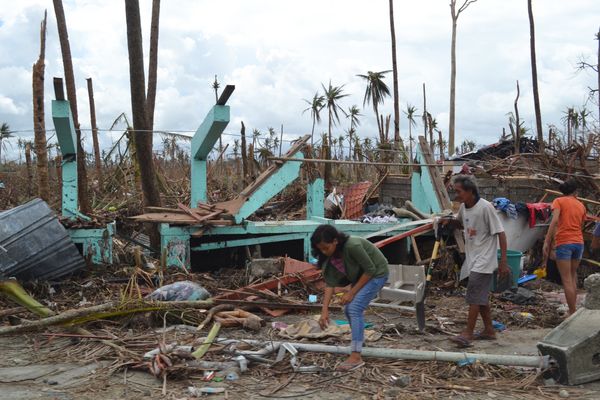
- The storm formed over the warm tropical waters of the Pacific Ocean and moved westwards.
- Winds reached 275 km/hr.
- The storm surge devastated the city of Tacloban on the island of Leyte.
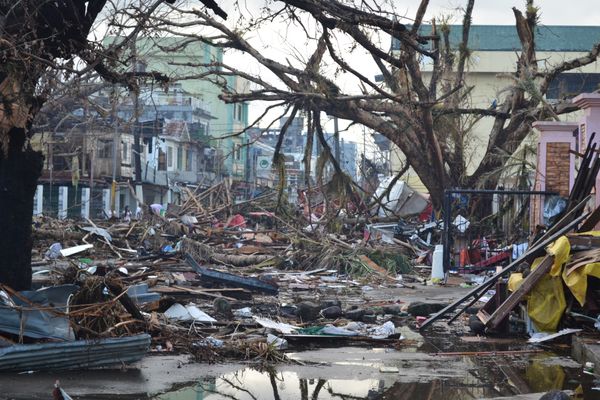
Primary effects
- 6,300 were killed.
- Damage to 40,000 homes.
- 90% of the city of Tacloban was destroyed.
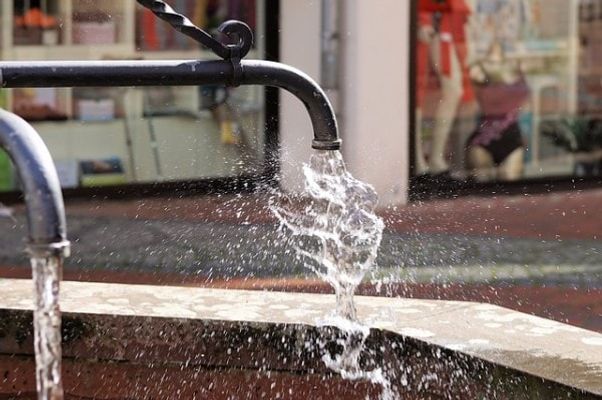
Secondary effects
- Roads were blocked by landslides that were caused by flooding.
- Disease outbreaks were caused by a lack of clean water and sanitation.

Responses to Typhoon Haiyan
- Overseas aid from NGOs (non-governmental organisations).
- 1,200 evacuation centres were set up.
- Aid in the forms of finance and supplies from the UN (United Nations).
- Homes were rebuilt in safer areas.
1 The Challenge of Natural Hazards
1.1 Natural Hazards
1.1.1 Natural Hazards
1.1.2 Types of Natural Hazards
1.1.3 Factors Affecting Risk
1.1.4 People Affecting Risk
1.1.5 Ability to Cope With Natural Hazards
1.1.6 How Serious Are Natural Hazards?
1.1.7 End of Topic Test - Natural Hazards
1.1.8 Exam-Style Questions - Natural Hazards
1.2 Tectonic Hazards
1.2.1 The Earth's Layers
1.2.2 Tectonic Plates
1.2.3 The Earth's Tectonic Plates
1.2.4 Convection Currents
1.2.5 Plate Margins
1.2.6 Volcanoes
1.2.7 Volcano Eruptions
1.2.8 Effects of Volcanoes
1.2.9 Primary Effects of Volcanoes
1.2.10 Secondary Effects of Volcanoes
1.2.11 Responses to Volcanic Eruptions
1.2.12 Immediate Responses to Volcanoes
1.2.13 Long-Term Responses to Volcanoes
1.2.14 Earthquakes
1.2.15 Earthquakes at Different Plate Margins
1.2.16 What is an Earthquake?
1.2.17 Measuring Earthquakes
1.2.18 Immediate Responses to Earthquakes
1.2.19 Long-Term Responses to Earthquakes
1.2.20 Case Studies: The L'Aquila Earthquake
1.2.21 Case Studies: The Kashmir Earthquake
1.2.22 Earthquake Case Study: Chile 2010
1.2.23 Earthquake Case Study: Nepal 2015
1.2.24 Reducing the Impact of Tectonic Hazards
1.2.25 Protecting & Planning
1.2.26 Living with Tectonic Hazards 2
1.2.27 End of Topic Test - Tectonic Hazards
1.2.28 Exam-Style Questions - Tectonic Hazards
1.2.29 Tectonic Hazards - Statistical Skills
1.3 Weather Hazards
1.3.1 Winds & Pressure
1.3.2 The Global Atmospheric Circulation Model
1.3.3 Surface Winds
1.3.4 UK Weather Hazards
1.3.5 Changing Weather in the UK
1.3.6 Tropical Storms
1.3.7 Tropical Storm Causes
1.3.8 Features of Tropical Storms
1.3.9 The Structure of Tropical Storms
1.3.10 The Effect of Climate Change on Tropical Storms
1.3.11 The Effects of Tropical Storms
1.3.12 Responses to Tropical Storms
1.3.13 Reducing the Effects of Tropical Storms
1.3.14 Tropical Storms Case Study: Katrina
1.3.15 Tropical Storms Case Study: Haiyan
1.3.16 UK Weather Hazards Case Study: Somerset 2014
1.3.17 End of Topic Test - Weather Hazards
1.3.18 Exam-Style Questions - Weather Hazards
1.3.19 Weather Hazards - Statistical Skills
1.4 Climate Change
1.4.1 Climate Change
1.4.2 Evidence for Climate Change
1.4.3 Natural Causes of Climate Change
1.4.4 Human Causes of Climate Change
1.4.5 Effects of Climate Change on the Environment
1.4.6 Effects of Climate Change on People
1.4.7 Climate Change Mitigation Strategies
1.4.8 Adaptation to Climate Change
1.4.9 End of Topic Test - Climate Change
1.4.10 Exam-Style Questions - Climate Change
1.4.11 Climate Change - Statistical Skills
2 The Living World
2.1 Ecosystems
2.1.1 Ecosystems
2.1.2 Food Chains & Webs
2.1.3 Ecosystem Cascades
2.1.4 Global Ecosystems
2.1.5 Ecosystem Case Study: Freshwater Ponds
2.2 Tropical Rainforests
2.2.1 Tropical Rainforests
2.2.2 Interdependence of Tropical Rainforests
2.2.3 Adaptations of Plants to Rainforests
2.2.4 Adaptations of Animals to Rainforests
2.2.5 Biodiversity of Tropical Rainforests
2.2.6 Deforestation
2.2.7 Impacts of Deforestation
2.2.8 Case Study: Deforestation in the Amazon Rainforest
2.2.9 Why Protect Rainforests?
2.2.10 Sustainable Management of Rainforests
2.2.11 Case Study: Malaysian Rainforest
2.2.12 End of Topic Test - Tropical Rainforests
2.2.13 Exam-Style Questions - Tropical Rainforests
2.2.14 Deforestation - Statistical Skills
2.3 Hot Deserts
2.3.1 Hot Deserts
2.3.2 Interdependence in Hot Deserts
2.3.3 Adaptation of Plants to Hot Deserts
2.3.4 Adaptation of Animals to Hot Deserts
2.3.5 Biodiversity in Hot Deserts
2.3.6 Case Study: Sahara Desert
2.3.7 Desertification
2.3.8 Reducing the Risk of Desertification
2.3.9 Case Study: Thar Desert
2.3.10 End of Topic Test - Hot Deserts
2.3.11 Exam-Style Questions - Hot Deserts
2.4 Tundra & Polar Environments
2.4.1 Overview of Cold Environments
2.4.2 Interdependence of Cold Environments
2.4.3 Adaptations of Plants to Cold Environments
2.4.4 Adaptations of Animals to Cold Environments
2.4.5 Biodiversity in Cold Environments
2.4.6 Case Study: Alaska
2.4.7 Sustainable Management
2.4.8 Case Study: Svalbard
2.4.9 End of Topic Test - Tundra & Polar Environments
2.4.10 Exam-Style Questions - Cold Environments
3 Physical Landscapes in the UK
3.1 The UK Physical Landscape
3.1.1 The UK Physical Landscape
3.1.2 Examples of the UK's Landscape
3.2 Coastal Landscapes in the UK
3.2.1 Types of Wave
3.2.2 Weathering
3.2.3 Mass Movement
3.2.4 Processes of Erosion
3.2.5 Wave-Cut Platforms
3.2.6 Headlands & Bays
3.2.7 Caves, Arches & Stacks
3.2.8 Longshore Drift
3.2.9 Sediment Transport
3.2.10 Deposition
3.2.11 Spits, Bars & Sand Dunes
3.2.12 Coastal Management - Hard Engineering
3.2.13 Coastal Management - Soft Engineering
3.2.14 Case Study: Landforms on the Dorset Coast
3.2.15 Coastal Management - Managed Retreat
3.2.16 Coastal Management Case Study - Holderness
3.2.17 Coastal Management Case Study: Swanage
3.2.18 Coastal Management Case Study - Lyme Regis
3.2.19 End of Topic Test - Coastal Landscapes in the UK
3.2.20 Exam-Style Questions - Coasts
3.3 River Landscapes in the UK
3.3.1 The Long Profile of a River
3.3.2 The Cross Profile of a River
3.3.3 Vertical & Lateral Erosion
3.3.4 River Valley Case Study - River Tees
3.3.5 Processes of Erosion
3.3.6 Sediment Transport
3.3.7 River Deposition
3.3.8 Waterfalls & Gorges
3.3.9 Interlocking Spurs
3.3.10 Meanders
3.3.11 Oxbow Lakes
3.3.12 Floodplains
3.3.13 Levees
3.3.14 Estuaries
3.3.15 Case Study: The River Clyde
3.3.16 River Management
3.3.17 Hydrographs
3.3.18 Flood Defences - Hard Engineering
3.3.19 Flood Defences - Soft Engineering
3.3.20 River Management Case Study - Boscastle
3.3.21 River Management Case Study - Banbury
3.3.22 End of Topic Test - River Landscapes in the UK
3.3.23 Exam-Style Questions - Rivers
3.4 Glacial Landscapes in the UK
3.4.1 The UK in the Last Ice Age
3.4.2 Glacial Processes
3.4.3 Glacial Landforms Caused by Erosion
3.4.4 Tarns, Corries, Glacial Troughs & Truncated Spurs
3.4.5 Types of Moraine
3.4.6 Drumlins & Erratics
3.4.7 Snowdonia
3.4.8 Land Use in Glaciated Areas
3.4.9 Conflicts in Glacial Landscapes
3.4.10 Tourism in Glacial Landscapes
3.4.11 Coping with Tourism Impacts in Glacial Landscapes
3.4.12 Case Study - Lake District
3.4.13 End of Topic Test - Glacial Landscapes in the UK
3.4.14 Exam-Style Questions - Glacial Landscapes
4 Urban Issues & Challenges
4.1 Urban Issues & Challenges
4.1.1 Urbanisation
4.1.2 Factors Causing Urbanisation
4.1.3 Megacities
4.1.4 Urbanisation Case Study: Lagos
4.1.5 Urbanisation Case Study: Rio de Janeiro
4.1.6 UK Cities
4.1.7 Case Study: Urban Regen Projects - Manchester
4.1.8 Case Study: Urban Change in Liverpool
4.1.9 Case Study: Urban Change in Bristol
4.1.10 Sustainable Urban Life
4.1.11 Reducing Traffic Congestion
4.1.12 End of Topic Test - Urban Issues & Challenges
4.1.13 Exam-Style Questions - Urban Issues & Challenges
4.1.14 Urban Issues -Statistical Skills
5 The Changing Economic World
5.1 The Changing Economic World
5.1.1 Measuring Development
5.1.2 Limitations of Developing Measures
5.1.3 Classifying Countries Based on Wealth
5.1.4 The Demographic Transition Model
5.1.5 Stages of the Demographic Transition Model
5.1.6 Physical Causes of Uneven Development
5.1.7 Historical Causes of Uneven Development
5.1.8 Economic Causes of Uneven Development
5.1.9 Consequences of Uneven Development
5.1.10 How Can We Reduce the Global Development Gap?
5.1.11 Case Study: Tourism in Kenya
5.1.12 Case Study: Tourism in Jamaica
5.1.13 Case Study: Economic Development in India
5.1.14 Case Study: Aid & Development in India
5.1.15 Case Study: Economic Development in Nigeria
5.1.16 Case Study: Aid & Development in Nigeria
5.1.17 End of Topic Test - The Changing Economic World
5.1.18 Exam-Style Questions - The Changing Economic World
5.1.19 Changing Economic World - Statistical Skills
5.2 Economic Development in the UK
5.2.1 Causes of Economic Change in the UK
5.2.2 The UK's Post-Industrial Economy
5.2.3 The Impacts of UK Industry on the Environment
5.2.4 Change in the UK's Rural Areas
5.2.5 Transport in the UK
5.2.6 The North-South Divide
5.2.7 Regional Differences in the UK
5.2.8 The UK's Links to the World
6 The Challenge of Resource Management
6.1 Resource Management
6.1.1 Global Distribution of Resources
6.1.2 Uneven Distribution of Resources
6.1.3 Food in the UK
6.1.4 Agribusiness
6.1.5 Demand for Water in the UK
6.1.6 Water Pollution in the UK
6.1.7 Matching Supply & Demand of Water in the UK
6.1.8 The UK's Energy Mix
6.1.9 Issues with Sources of Energy
6.1.10 Resource Management - Statistical Skills
6.2.1 Areas of Food Surplus & Food Deficit
6.2.2 Increasing Food Consumption
6.2.3 Food Supply & Food Insecurity
6.2.4 Impacts of Food Insecurity
6.2.5 Increasing Food Supply
6.2.6 Case Study: Thanet Earth
6.2.7 Creating a Sustainable Food Supply
6.2.8 Case Study: Agroforestry in Mali
6.2.9 End of Topic Test - Food
6.2.10 Exam-Style Questions - Food
6.2.11 Food - Statistical Skills
6.3.1 Water Surplus & Water Deficit
6.3.2 Increasing Water Consumption
6.3.3 What Affects the Availability of Water?
6.3.4 Impacts of Water Insecurity
6.3.5 Increasing Water Supplies
6.3.6 Case Study: Water Transfer in China
6.3.7 Sustainable Water Supply
6.3.8 Case Study: Kenya's Sand Dams
6.3.9 Case Study: Lesotho Highland Water Project
6.3.10 Case Study: Wakel River Basin Project
6.3.11 Exam-Style Questions - Water
6.3.12 Water - Statistical Skills
6.4.1 Global Demand for Energy
6.4.2 Increasing Energy Consumption
6.4.3 Factors Affecting Energy Supply
6.4.4 Impacts of Energy Insecurity
6.4.5 Increasing Energy Supply - Solar
6.4.6 Increasing Energy Supply - Water
6.4.7 Increasing Energy Supply - Wind
6.4.8 Increasing Energy Supply - Nuclear
6.4.9 Increasing Energy Supply - Fossil Fuels
6.4.10 Carbon Footprints
6.4.11 Energy Conservation
6.4.12 Case Study: Rice Husks in Bihar
6.4.13 Exam-Style Questions - Energy
6.4.14 Energy - Statistical Skills
Jump to other topics

Unlock your full potential with GoStudent tutoring
Affordable 1:1 tutoring from the comfort of your home
Tutors are matched to your specific learning needs
30+ school subjects covered
Tropical Storms Case Study: Katrina
UK Weather Hazards Case Study: Somerset 2014
- High School
- You don't have any recent items yet.
- You don't have any modules yet.
- You don't have any books yet.
- You don't have any Studylists yet.
- Information
Tropical storms - case study
Physical geography, sixth form (a levels), high school - united kingdom.
Recommended for you
Students also viewed.
- Management of Holderness Coast
- AQA A Level Geography: Water and Carbon Cycles Detailed Notes
- AQA A Level Geography: Hazards Detailed Notes
- Modifying the Event 1
- Volcanic Hazards Case Studies
- River regimes
Related documents
- Environmental Change in Tropical Rainforests
- Geog ocean prep
- Brazil human rights
- Maria Thomas - Health AND Social CARE UNIT 5 TASK 1 Forms
- 9696 s23 qp 21 - fvdjvifdvnmidfjv
- Hazardous Earth copy copy
Related Studylists
Preview text.
A tropical storm is a a localized, very intense low-pressure wind system, forming over tropical oceans and with winds of hurricane force. A tropical storm must have average wind speeds in excess of 120 km/h and can extend to 500 km/h.
Characteristics; There is a degree of symmetry around its central point or ‘eye’. The most powerful and damaging part of a tropical storm is the menacing bank of cloud that rings the central eye. This is called the eye wall. As shown in this diagram, cloud and rain extend in a series of waves well beyond the eye wall.
This is Hurricane Katrina, which killed over 1800 people and caused more economic damage in the USA than any previous natural disaster.
Distribution of tropical storms;
The vast majority of tropical storms occur and formed in the tropics, although they do extend beyond their regions is places such as China,
Tropical Storms
Japan, and the eastern sea board of the USA. The region which experiences the most tropical storms is Eastern Asia (33%) of the total, East Pacific (17%), West Australia (13%) and the Caribbean (11%). The reason for this is because the temperatures in these areas are warm enough (roughly 26 degrees Celcius), to be able to form a tropical storm and is also not at the equator because along the tropic of cancer and capricon, there is enough spin influenced by the earths spinning. Important factors affecting the distribution of tropical storms;
Oceans – Tropical storms derive their moisture (through the transfer of evaporation) and energy (in the form of latent heat) from the oceans; there are clear links with the water cycle. This explains why tropical storms form and continue to develop over ocean areas and the decrease out on reaching land. High temperatures – a sea-surface temperature in excess of 26 degrees Celcius is required for tropical storm formation, which is why they are formed in low latitudes during the summer, when temperatures are at their highest. Atmospheric instability – tropical storms are most likely to form in regions of intense atmospheric instability, where warm air is being forced to rise. The ITCZ, where two limbs of the Hadley Cell converge to form low pressure on the ground, is a perfect spawning ground for tropical storms. Rotation of the Earth – a certain amount of ‘spin’ is needed to initiate the characteristic rotating motion of a tropical storm. The influence of the Earth’s rotation on surface phenomena is called Coriolis effect. This increases with distance away from the Equator and explains why tropical storms do not usually form in the region between 5 degrees north and 5 degrees south (close to the Equator). Uniform wind direction at all levels – winds from different directions at altitude prevent a tropical storm from attaining height and intensity. The vertical development is effectively ‘sheared off’ by the multidirectional winds.
Tropical Storm formation;
- The hot air, being lighter than the cooler air around it, rises taking a lot of water vapour with it. As the water vapour rises up it cools to form big cumulus clouds. This creates low pressure at sea level. Wherever you have low pressure, air with higher pressure tends to move in to replace it.
- A central vortex will develop as more and more air is drawn in and rises. The very centre of the storm (the eye) is often characterised by a column of dry sinking air.
- As the air rises, it rapidly cools. This leads to condensation and the formation of towering cumulonimbus clouds. Sometimes a number of isolated thunderstorms will coalesce to form `a single giant storm. When condensation occurs, latent heat is released, which effectively powers the storm.
- We have the hot air rising, the air coming in from outside and coming under the cloud in a spin, picking up more water vapour and spiralling upwards as it warms. This has 2 effects; the first is that the storm clouds begin to be pulled into a spin by the incoming wind.
- The second effect is that the spinning storm is pulled outward – leaving a low pressure funnel at the centre.
- Now way up high there is cold air which is under higher pressure so this is sinks down into the centre – at the bottom this begins
This flow of air occurs because the Sun heats air at the Earth’s surface near the equator. The warm air rises, creating a band of low pressure at the equator. Once the rising air reaches the top of the troposphere at approximately 10 – 15 km above the Earth’s surface, the air flows toward the north and south poles. The Hadley cell eventually returns air to the surface of the Earth in the subtropics, near 30 degrees north or south latitude.
Air near the surface flows toward the equator into the low pressure area, replacing the rising air. This area of low pressure and converging winds (air flowing together) is called the Intertropical Convergence Zone. These winds are turned toward the west by the Coriolis effect and become the trade winds or the tropical easterlies.
The air that returns back to the surface of the Earth in the subtropics produces a band of high pressure called the subtropical high. Once the air reaches the surface, some air flows toward the equator from the subtropical high to the lower pressure in the ITCZ to become part of the trade winds.
ARE HURRICANES BECOMING MORE SEVERE AND FREQUENT DUE TO
Climate change.
As global warming causes oceans to become warmer, and more moisture is held in the atmosphere, the intensity of hurricanes and the amount of rain they produce will likely increase. In the 30 to 50 years the oceans have warmed about 0 degree Fahrenheit. This may not seem like much of a temperature change, but it is quite significant. The oceans have an enormous heat capacity because of their large size it takes a great amount of heat to warm them. The warming oceans are very likely causing the strength of hurricanes to increase. Hurricanes take heat energy from the oceans and convert it into the energy of the storm. The warmer oceans offer more heat energy to hurricanes. This makes them become stronger storms.
Damaging hurricanes, cyclones and typhoons occur in tropical parts of the world, at the time of year when the sea is warmest. So, if the world gets warmer still, the risk increases. In particular, when one follows much the same track as another, soon afterwards, the second or third is usually likely to be weaker – since the surface ocean will have been cooled by the initial mixing (bringing deeper, lower-temperature water to the surface). But that effect won't happen, or will be much less, if there's warm water at depth as well as at in the uppermost layers. We see there has been some overlap of the 'flight paths' of Harvey, Irma and Jose, yet without resulting in any substantive reduction in their strengths, all being at least category 4.
How does climate change make storms worse? Climate change leads to warmer atmosphere and conditions. The Clausius – Clapeyron equations shows that for every half a degree Celsius in warming, there is about a 3% increase in atmospheric moisture content. Warmer seas lead’s, to faster and more evaporation, and warmer air holds more water vapour. Therefore as temperatures rise around the world, the atmosphere stores more water vapour and moisture which can form more violent storms, more frequently.
Primary Effects of Tropical Storms
Strong winds Strong winds can damage or destroy vehicles, buildings, bridges, personal property and other outside objects, turning loose debris into deadly flying projectiles. Tropical cyclones often knock out power to tens or hundreds of thousands of people, preventing vital communication and hampering rescue efforts. Tropical cyclones often destroy key bridges, overpasses, and roads, complicating efforts to transport food, clean water, and medicine to the areas that need it.
Furthermore, the damage caused by tropical cyclones to buildings and dwellings can result in economic damage to a region.
Storm Surges The storm surge, or the increase in sea level due to the cyclone, is typically the worst effect from land-falling tropical cyclones, historically resulting in 90% of tropical cyclone deaths. The storm surge, or the increase in sea level due to the cyclone, is typically the worst effect from land-falling tropical cyclones, historically resulting in 90% of tropical cyclone deaths The storm surges and winds of hurricanes may be destructive to human-made structures, but they also stir up the waters of coastal estuaries, which are typically important fish breeding locales.
Heavy Rainfall The thunderstorm activity in a tropical cyclone produces intense rainfall, potentially resulting in flooding, mudslides, and landslides. Inland areas are particularly vulnerable to freshwater flooding, due to residents not preparing adequately. Heavy inland rainfall eventually flows into coastal estuaries, damaging marine life in coastal estuaries.[ The wet environment in the aftermath of a tropical cyclone, combined with the destruction of sanitation facilities and a warm tropical climate, can induce epidemics of disease which claim lives long after the storm passes. Infections of cuts and bruises can be greatly amplified by wading in sewage-polluted water. Large areas of standing water caused by flooding also contribute to mosquito-borne illnesses.
Environmental effects
A huge amount of water is released in a tropical storm so there will be extensive flooding. Flooding might led to swer systems being flushed out and spreading disease. There will be structural damage to buildings and they may have to be pulled down and rebuilt. This is very costly. Other buildings may have broken windows, chimneys etc. Roads and other infrastructure such as railways may be destroyed. This can lead to communication problems. Electricity lines might be blown down and, as a result, people could be without power supplies. Sensitive ecosystems may be destroyed and plant and animal habitats lost. Sea fish are often killed because of silting, and freshwater fish may be killed in storm surges. Fishing boats and other craft may be damaged. Crops and livestock may be damaged or destroyed. Mudslides become common because the soil is saturated. They will flow quickly down hillsides and may bury houses, crops and livestock (or even people).
Social effects
The first stage in any impending disaster is for the government to declare a state of emergency, as this often triggers federal / state support both financially and also in terms of mobilising armed forces and emergency services. Immediately after disaster has struck, most governments seek support from the international community, particularly neighbouring countries and those with historical, political, or economic links. Disaster aid can take the form of expert personnel (e. engineers, doctors, search and rescue). Longer term aid may come from a variety of sources and could take the form of either a loan to help a country rebuild or direct help, for example, involving charities working with stricken countries. Insurance – People living in hurricane – prone areas are encouraged to take out insurance against wind damage and to follow certain building codes and regulations.
Prevention Tropical storms are natural hazards which cannot be prevented but it is possible to mitigate some of its effects. Sea walls can be constructed to protect coastal developments from storm surges and river flood defences can help to protect property and land from flooding.
Adaption Adapting to the threats posed by tropical storms is for many people around the world the most realistic options. An example of adaption involves land – use zoning that aims to reduce the vulnerability of people and property at the coasts. In parts of north – eastern Florida, coastal properties are raised above the ground on stilts, and have non -residential functions on the ground floor, such as a garage or storage area. Storm surge elevation markers help to give an indication of which buildings are at risk when a storm warning is issued. The use of improved wind-resistant structures in building design was mandatory, which has proved to be effective in reducing losses.
- Multiple Choice
Subject : Physical Geography

- Discover more from: Physical Geography Sixth Form (A Levels) 570 Documents Go to course
- More from: Physical Geography Sixth Form (A Levels) 570 Documents Go to course
- More from: geography by Ana Nelson 26 26 documents Go to Studylist

IMAGES
COMMENTS
Epping Forest Case Study; The Tropical Rainforest. What is a Tropical Rainforest? Where are tropical rainforests located? ... close to Tacloban on 8th November, 2013 at 4.40 am. The tropical storm originated in the northwest Pacific Ocean. It is one of the most powerful typhoons to affect the Philippines. Wind speeds of 314 kilometres per hour ...
Tropical cyclones: case study. Specification. Primary and secondary impacts of one named tropical cyclone. Primary and secondary impacts. Primary impacts or effects of a natural disaster are those things which have been caused directly by the physical event. For a tropical cyclone these will include direct damage due to high winds, flooding due ...
Case Study: Hurricane Katrina. The First Four Days • Tropical Depression Twelve • Tropical Storm Katrina • Category 1 hurricane • Weakens to tropical storm • Strengthens to Category 2 over Gulf of Mexico. Saturday August 27th • Strengthens to Category 3, and doubles in size • Louisiana implements Evacuation Plan
with wind speeds of 115 mph) - before weakening to a tropical storm while tracking through the Bahamas (Blake et al., 2013). At this time, Sandy experienced a complex transformation with its wind field expanding to over 1,600 km in diameter, making it the largest tropical storm on record (Blake et al., 2013) (Figure 1).
Epping Forest Case Study; The Tropical Rainforest. What is a Tropical Rainforest? Where are tropical rainforests located? ... Hurricane Katrina was a category five tropical storm. The hurricane caused storm surges over six metres in height. The city of New Orleans was one of the worst affected areas. This is because it lies below sea level and ...
Cyclone Idai Case Study - Find out about the causes, primary and secondary effects and immediate and long term responses to Cyclone Idai. X; Facebook; Youtube; 0 Shopping Cart ... Now a tropical depression, the storm becomes more intense between coastal Africa and Madagascar. ...
Chapter 14 Study Guide Case Studies Case Study 1: 2005 Hurricane Katrina Hurricane Katrina was only the 3rd strongest of a very busy Atlantic hurricane season. But it was the most destructive, with over 1800 fatalities and large destruction from the storm surge in New Orleans but also elsewhere. The Caribbean-type hurricane formed
1 ial geography 10 tropical cyclones case study: tropical cyclones 3.3.2: tropical cyclones are a major short-term weather hazard impact of tropical cyclones: hurricane michael vs. typhoon mangkhut hurricane michael, usa: 10 october 2018 typhoon mangkhut, philippines and south china: 15 september 2018 category 4 5 wind speed 155 mph 240-270 mph
The storm formed over the warm tropical waters of the Pacific Ocean and moved westwards. Winds reached 275 km/hr. The extreme low-pressure system brought a storm surge of 5m. ... 5.1.11 Case Study: Tourism in Kenya. 5.1.12 Case Study: Tourism in Jamaica. 5.1.13 Case Study: Economic Development in India.
A tropical storm is a a localized, very intense low-pressure wind system, forming over tropical oceans and with winds of hurricane force. A tropical storm must have average wind speeds in excess of 120 km/h and can extend to 500 km/h. Characteristics; There is a degree of symmetry around its central point or 'eye'.